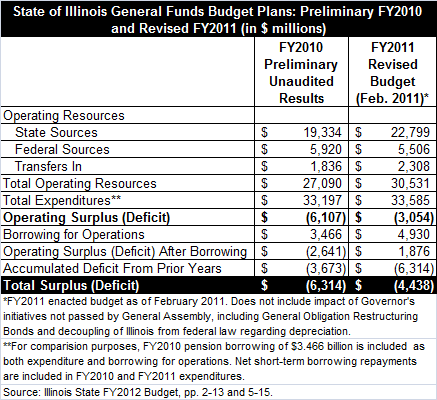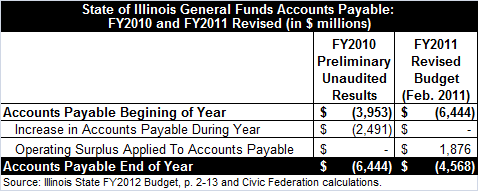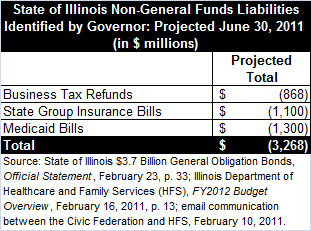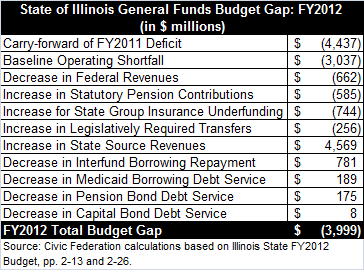March 24, 2011
After three years of increasing budget deficits, the State of Illinois is expected to see a smaller budget gap at the end of FY2011 because of tax increases and expanded borrowing for operations.
The FY2011 year-end deficit is currently projected to total $4.4 billion, according to Civic Federation calculations based on information in Governor Pat Quinn’s FY2012 recommended budget. That compares with a total budget gap of $6.3 billion in FY2010.
The table below shows factors contributing to the budget deficits in FY2010 and FY2011.

The initial operating deficit is expected to decline from $6.1 billion in FY2010 to $3.1 billion in FY2011, largely reflecting additional state revenues due to the income tax increases enacted on January 13, 2011 and effective beginning on January 1, 2011. The personal income tax rose from 3% to 5% until January 1, 2015. After that, the personal income tax rate is scheduled to be set at 3.75% until 2025, when it will drop to 3.25%. The corporate income tax rose from 4% to 7.8% until January 1, 2015. It is then scheduled to be set at 5.25% until 2025, when it will return to 4.8%. Illinois corporations also pay a Personal Property Replacement Tax (PPRT) of 2.5%.
According to the Governor’s FY2012 budget, the personal tax rate increase is expected to generate an additional $2.9 billion in gross receipts in FY2011 and the corporate tax increase is expected to generate an additional $180 million. Gross receipts are tax collections before deposits into the Income Tax Refund Fund, the state fund used to pay refunds owed to taxpayers.
After these changes in FY2011, the initial operating deficit of $3.1 billion is more than offset by $4.9 billion in proceeds from sales of pension bonds and of bonds based on the settlement of tobacco litigation. The resulting operating surplus of $1.9 billion is applied to the accumulated deficit from prior years of $6.3 billion, reducing the total deficit to $4.4 billion.
The numbers above for FY2011 do not reflect two proposals by the Governor that have not been passed by the General Assembly: additional borrowing of $8.75 billion, $4 billion of which is proposed to be applied to General Funds in FY2011 (and $98 million in related debt service) and roughly $82.5 million in increased revenues from not following federal law regarding bonus depreciation for corporations.
The next table shows the State’s General Funds backlog of unpaid bills, or accounts payable, at the end of FY2010 and FY2011. As in the previous table, these numbers do not reflect the Governor’s initiatives that have not been approved.

The backlog of unpaid bills would decline from $6.4 billion at the end of FY2010 to $4.6 billion at the end of FY2011 by using the operating surplus after borrowing of $1.9 billion in FY2011 to pay down the bills.
Under Governor Quinn’s plan, all but $600 million of accounts payable would be paid off. Using $4 billion in proceeds from the 15-year $8.75 billion borrowing, the Governor’s plan would result in an operating surplus after borrowing of $5.9 billion. Of that operating surplus, $5.8 billion would be used to pay off the $6.4 billion bill backlog, leaving accounts payable of $600 million at the end of FY2011.
The Governor has also identified other State obligations outside of the General Funds that would be paid off using the proposed borrowing. The next table provides an estimate of those obligations at the end of FY2011.

While still supporting the $8.75 billion borrowing, the Governor has recently discussed the idea of a short-term borrowing to pay roughly $2 billion in non-General Funds obligations relating to group insurance and Medicaid.
Entering FY2012 the State’s projected General Funds deficit is roughly $4.0 billion. The deficit starts with the $4.4 billion gap projected to be carried forward from FY2011. The State will also begin FY2012 with a baseline operating deficit of $3.1 billion, which is the budgetary imbalance before any changes to revenues and expenditures. The State then is expected to see certain known changes in revenues and expenditures, as shown in the table below.
The most significant change relates to the increase in state source revenues generated by the first full year of the income tax increases. This is offset by decreased federal revenues stemming partly from the end of the federal stimulus program, increased pension contributions and increased funding for group health insurance, which was severely underfunded in FY2011.
The table is based on information in the Governor’s FY2012 budget. However, it does not reflect any additional spending pressures, such as contractual wage increases. In addition, it does not incorporate the Governor’s proposed $8.75 billion borrowing. Under the Governor’s plan $1.45 billion of the proceeds would be used for General Funds operations in FY2012 and $403 million would be required for debt service on the $8.75 billion borrowing.
